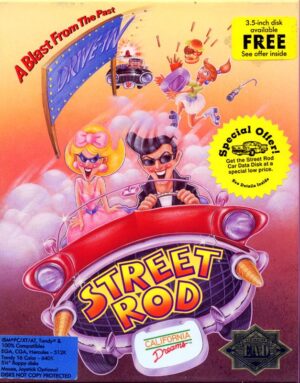Retro Replay Review
Gameplay
The Secret Diary of Adrian Mole Aged 13¾ offers a refreshingly approachable take on interactive fiction by streamlining the traditional parser model into a choice-based system. Instead of wrestling with verb-noun commands, players read short passages—many lifted verbatim from Sue Townsend’s original book—and are presented with three distinct actions. Each choice steers Adrian down different narrative paths, ensuring that decision-making feels both meaningful and infused with teenage awkwardness.
One of the game’s most charming mechanics is the built-in “Help” option, which provides concise character dossiers whenever you need a reminder of Pandora’s latest mood swings or Barry Kent’s current bullying tactics. This handy reference prevents confusion, especially for newcomers, and deepens the sense that you’re truly navigating Adrian’s chaotic social web. As you progress, your actions are reflected in a popularity meter that calculates your ranking at key intervals—from “a spotty creep” at 26% to “a middling thicko” at 38%—adding a playful scoreboard element to the storytelling.
Pacing is brisk, with most modules taking only a few minutes to complete before you’re prompted to make another decision. This bite-sized approach makes it easy to pick up and play in short bursts, yet the cumulative effect of your choices shapes Adrian’s social standing in surprisingly nuanced ways. Though there’s no hidden object hunting or elaborate puzzles, the emphasis on character interaction and reputation management turns every diary entry into a small adventure.
Graphics
As a mid-1980s Level 9 release, The Secret Diary of Adrian Mole leans heavily on evocative text rather than visual spectacle. You won’t find colorful sprites or animated backdrops here; instead, the game relies on Townsend’s witty prose and your imagination to paint scenes of suburban England. For many players, this minimalist presentation is part of the charm, echoing the feel of reading an actual diary.
In lieu of detailed graphics, brief ASCII illustrations occasionally frame chapter titles or denote scene transitions. These simple line drawings—depicting a quill, a school desk, or a scruffy pensioner like Bert Baxter—serve as visual bookmarks without distracting from the narrative flow. While fans of high-resolution artwork may feel the absence of conventional visuals, text adventure enthusiasts will appreciate the purity of focus on story and choice.
Sound effects and music are notably absent, which can be a double-edged sword. On one hand, the silence allows you to fully absorb Townsend’s razor-sharp satire; on the other, it may feel sparse compared to more multimedia-driven titles. Nevertheless, the game’s crisp typography and clear menu prompts ensure that navigating each diary entry remains intuitive and frustration-free.
Story
Sue Townsend’s original diary sparked a cultural phenomenon in the mid-1980s by blending sharp social commentary with the heartfelt confusion of adolescence. Level 9’s adaptation preserves the novel’s trademark humor, delivering many of the author’s most memorable passages verbatim. Whether Adrian is obsessing over the “mental” stigma of his school uniform or fretting that Pandora might prefer his best mate Nigel to him, the writing crackles with teenage authenticity.
The game assembles an all-star cast from the book: Adrian’s feuding parents, each embroiled in their own romantic disasters; the beleaguered school bully Barry Kent; earnest best friend Nigel; and the delightfully cantankerous pensioner Bert Baxter. Interactions with these characters feel organic, with each choice unlocking new banter, embarrassing revelations, or unexpected heartwarming moments. True to Townsend’s style, the narrative deftly balances farce and pathos.
At its core, the story is about the pursuit of social acceptance. You guide Adrian as he navigates crushes, family upheaval, and the treacherous hallways of Lower Loxley Comprehensive. Periodic progress reports—complete with percentage scores and humorously insulting rank titles—underscore the game’s satirical edge: life may not hand you a perfect score, but the journey is full of laugh-out-loud observations.
Overall Experience
The Secret Diary of Adrian Mole Aged 13¾ stands out as a delightful relic of text-based gaming that still resonates today. It’s not padded with convoluted puzzles or flashy production values; instead, it invites players into a cozy, comedic world where your choices shape a teenager’s destiny. Fans of Townsend’s books will revel in hearing Adrian’s voice come to life, while newcomers will quickly understand why the diary became a publishing sensation.
Replay value is surprisingly high. Since each decision can influence Adrian’s popularity and relationship dynamics, multiple playthroughs reveal new anecdotes, secret interactions, and alternative endings. You might discover a scenario in which his parents reconcile—temporarily— or a more humiliating encounter with schoolmates, encouraging you to explore every branching path.
Ultimately, this adaptation is best suited for those who appreciate narrative-driven games and British wit. If you’re seeking complex graphics or fast-paced action, you may find it modest. But if you enjoy character-focused storytelling, comedic timing, and a light strategic layer of reputation management, The Secret Diary of Adrian Mole Aged 13¾ delivers an experience both charmingly retro and enduringly entertaining.
 Retro Replay Retro Replay gaming reviews, news, emulation, geek stuff and more!
Retro Replay Retro Replay gaming reviews, news, emulation, geek stuff and more!









Reviews
There are no reviews yet.